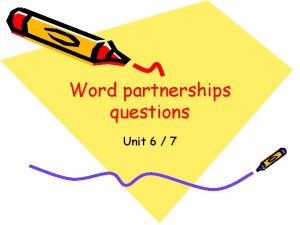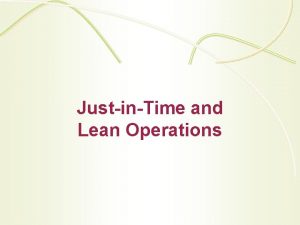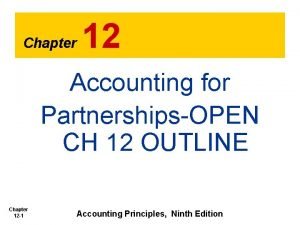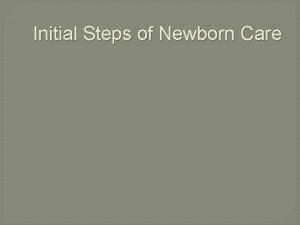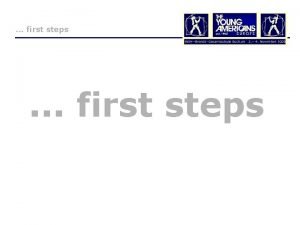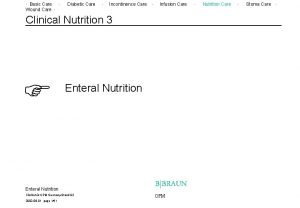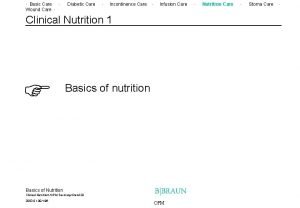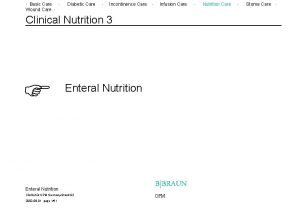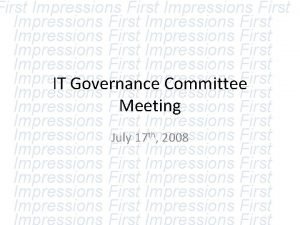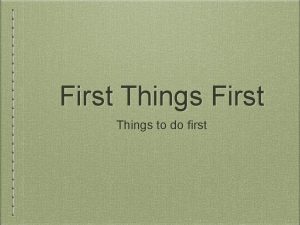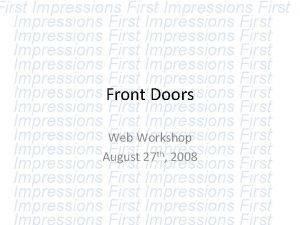FamilyStaff Partnerships First Steps Partnerships to Improve Care




















- Slides: 20

Family-Staff Partnerships: First Steps Partnerships to Improve Care and Quality of Life for Persons with Dementia

Training Goals for our series Enhance family involvement in the daily care of their loved ones Promote person-centered care Goals for today Review main elements of the Family Involvement in Care (FIC) Intervention Review steps to implement the intervention with family

Family Involvement in Care (FIC) Intervention 1. 2. 3. 4. 5. Orient family to the setting and to the idea of partnership Educate staff Goal of this training series! Negotiate and form partnership agreement with family Educate family members about staying involved in care Evaluate and renegotiate the agreement as needed Staff play different roles, but ALL need the “Big Picture” to be effective team members!!

Service Use = Family role change For the last year, I’ve done almost everything for him. I help him bathe and dress, go to the toilet, eat, and put him in bed. When he’s up, I’m up, and often in the middle of night. It’s strange now. I did so much for so long. Now I don’t know what I’m supposed to do. I don’t want to interfere or bother the staff – after all, I asked for their help. I worry they will do the right things, and hear them saying things I don’t understand. Everything is so different now.

Benefits of Staff-Family Partnerships v v v Enables staff to learn important details need to personalize care Helps family learn how to make a positive contribution Helps staff “educate” families about changes, needs of person Allows family to help support busy staff Enhances quality of care to the person with dementia Satisfaction increases for all involved!

Consider Family Needs Families who benefit most from partnerships with staff. . . v Have had the most responsibility for care (e. g. , spouse, daughter) v Are experiencing new and increasing caregiving demands v Are new to the care setting and/or care provider v Have a poor relationship with the setting and/or provider v Have a prior poor relationships with the person with dementia

Step 1. Orienting Family v Orient to care setting/service ü Tour the setting/service ü Introduce staff v Review philosophies and policies of the care setting/service ü Philosophy of dementia care ü Policies about visiting; family participation in care; communicating with families ü Staff roles, responsibilities ü Availability of resources, supports ü Environmental factors (e. g. , pets, freedom of movement, activities, access)

Step 1. Orienting Family, cont. v Introduce the idea of a “partnership” between families and staff ü Best done by key leader ü Discuss family concerns and expectations v Ask one family member to take a “leadership” role in partnership v Sign the form Family and Staff Statement of Partnership Intent v Complete assessments ü Family: Characteristics , concerns, expectations ü Person with dementia: level of function, needs

Discussion Questions v From/about family members ü What would be helpful for staff to know? ü What would you like to change? ü What would you like to see done differently? ü What specific needs does your loved one have? ü What are the best ways to meet those needs? ü How would you like to be involved? ü What do you hope will happen in partnership with staff? ü What concerns do you have about the partnership with staff? ü MORE!

Intervention Assessment Inventory v From/about family members ü Contact information for “Point-Person” and other family ü Family support; other social support ü Problems encountered in providing care ü Feelings about new care setting/service ü Expectations for participating in caregiving ü Major concerns about the new service/setting ü Expectations for staff ü Knowledge of dementia ü Current health ü Level stress in caregiving role

Intervention Assessment Inventory v Person with dementia ü Functional abilities? ü Self care abilities? ü Cognitive function? ü Pleasurable activities? v Also consider. . . ü Values ü Preferences ü Goals for care, treatment, engagement ü Longstanding interests, history ü Personality ü Life experiences

Step 3. Negotiation of Partnership Agreement v Partnership Negotiation Session: Dedicated time to work out specifics of the Partnership Agreement v Prepare for the Session ü Use information from Assessment Inventory ü Identify needs of person with dementia ü Include assisting staff (direct care) as much as possible ü Share information with family: brochures, activity/resource list ü Schedule a mutually agreeable time for the meeting

Step 3. Negotiation of Agreement, cont. v Partnership Negotiation Session ü Discuss goals and activities for family AND staff ü Identify mutually satisfying approaches v Partnership Agreement ü Writing out mutually agreed upon goals and activities ü Documenting the family caregiver’s involvement AND staff involvement

Partnership Agreements No “one right way” v Depends on lots of factors ü Who is the provider? ü What is the setting/type of care? ü What is the typical communication style or method? Can take different “formats” v Informal, verbal agreements v Written agreements (stronger approach)

Partnership Agreements Key elements of an agreement v Health & quality of life needs v Staff & family participants v Specific goals v Specific activities ü Physical ü Psychosocial/spiritual ü Leisure/recreational ü Financial v Target outcomes/monitoring

Partnership Agreement: Example Family and other caregivers have agreed that they are partners in planning, providing, and evaluating care for “Mary Smith. ” Partnership goals include: __________ To help reach these goal, “John Smith” will do the following activities: ________ Other caregivers will do the following activities: _______ Comments or explanations: _________ Signatures: Family Caregiver and Staff Caregivers

Step 4. Educate Family v Share information: begins at initial contact, continues throughout partnership v Base education on family needs ü Preferred level of involvement ü Knowledge of dementia ü Concerns, expectations for care v Use the companion training program for family Family Involvement in Care: Advancing Care Partnerships: https: //igec. uiowa. edu/fic

Step 4. Educate Family, cont. Family Resource Manual: Ideas for participating in care v General strategies: caring for persons with dementia ü How to approach, give directions, communicate effectively v Therapeutic activities: purpose and procedures ü Art therapy, music therapy, reminiscence, therapeutic recreation ü Exercise ü Eating/nutrition ü Simple Pleasures v Online resources: brochures, websites

Summary First steps in the Family Involvement in Care Intervention guide development of partnerships agreements! v Step 1: Orient families to your service ü Identify and discuss family concerns ü Conduct assessments to identify needs ü Sign an Partnership Intent form v Step 2: Educate staff Underway! v Step 3: Educate family

Coming up next v Family-Staff Partnerships: Negotiation in Dementia Care ü Principles of negotiation in forming a partnership agreement ü Conflict in negotiation
 Primary secondary tertiary care
Primary secondary tertiary care Accounting for partnerships chapter 12 solutions
Accounting for partnerships chapter 12 solutions Accenture development partnership
Accenture development partnership Complete the word partnerships with brand product or market
Complete the word partnerships with brand product or market Product development partnerships
Product development partnerships Jit scheduling tactics
Jit scheduling tactics Maintaining effective partnerships
Maintaining effective partnerships Account www.publicpartnerships.com
Account www.publicpartnerships.com Epsrc prosperity partnerships
Epsrc prosperity partnerships Chapter 12 accounting for partnerships answers
Chapter 12 accounting for partnerships answers These movements are also sometimes called axial movements.
These movements are also sometimes called axial movements. Meconimum
Meconimum Newborn apgar score
Newborn apgar score First steps in english linguistics chapter 8
First steps in english linguistics chapter 8 First dental home certification
First dental home certification Monash first steps
Monash first steps Standard 3 duty of care
Standard 3 duty of care Acul magnetic al unei busole se orienteaza
Acul magnetic al unei busole se orienteaza Palliative care versus hospice care
Palliative care versus hospice care Animale care nasc pui vii
Animale care nasc pui vii Care sunt simturile prin care sunt evocate
Care sunt simturile prin care sunt evocate



